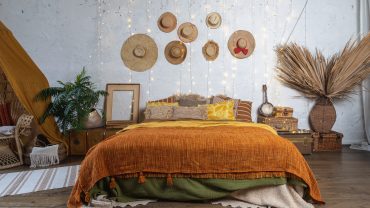There’s nothing quite like the vintage house design style for creating a home that exudes a mix of beauty, character, and sophistication. It’s the style that celebrates the history of style. It takes the best elements from past periods and showcases them to maximum effect. Put simply, it incorporates the very best elements from historical periods, such as those from the early to mid-20th century, to create nostalgic and timeless spaces.
Beyond this however, when it comes to vintage interior design, things start to get a little murky. For the question that needs to be asked is, just what counts as vintage? And what are the distinct characteristics that define vintage interiors? Read on to find out.
What is Vintage Interior Design?

A vintage polished fireplace and leather armchair (Credit: John Keeble via Getty Images)
Vintage interior design celebrates the best and highest quality decor from the past. Seems straightforward, right? But it’s also vague. And rather shifts the focus from what is vintage interior design onto that of when. In other words, what decades or periods fall under the remit of “vintage?” One way to narrow it down is by a process of elimination. For instance, it can be argued that vintage is anything younger than antique decor. And, while this is far from a term defined in stone, “antique” tends to refer to items over 100 years old.
Having said this, vintage can also include antique elements. Then there’s the issue of how young something can be to fall under the “vintage” umbrella. This is intensely subjective, with anything from 20 to 50 years as viable suggestions. So, how else can we narrow down the definition of vintage as it relates to interiors?
Characteristics of Vintage Decor

An 18th century French bombe elm sideboard (Credit: Andreas von Einsiedel via Getty Images)
Some styles, like Baroque, derive from artistic movements. Others, like Victorian or Georgian hark back to a certain era. In both cases there are defined parameters, often guidelines or customs to follow. But what are the defining features of the vintage house design style? Let’s take a look.
An Emphasis on Furniture
Furniture plays a pivotal role in vintage interior decor, with iconic styles such as mid-century modern and Art Deco being distinctive enough to create a sense of history. For example, mid-century modern furniture, known for its clean lines and organic forms, and the geometric opulence of Art Deco pieces, possess hallmarks that make them stand out as works of vintage style. Identifying authentic vintage furniture involves looking for specific design qualities and manufacturing characteristics that are unique to the period from which they originate.
Unique Textiles & Patterns
Vintage interiors often feature distinctive textiles like floral prints, velvet, and tweed. These materials add a touch of luxury and comfort that is characteristic of vintage decor. Patterns also play an essential role; polka dots and paisley are among the designs that help cement the vintage feel within a space. These elements are not just decorative; they’re also a reflection of the periods they represent and contribute to the overall authenticity of the design.
Distinctive Colour Palettes
The colour schemes associated with vintage interior design often include pastels and muted tones, which reflect the popular hues of the times and contribute to a warm, inviting atmosphere. Effectively blending these colours within modern settings requires a balanced approach to ensure that the vintage elements stand out without overwhelming contemporary aesthetics.
Decorative Accents
Accents such as lamps, mirrors, and artwork are integral to vintage decor, enhancing the aesthetic while staying true to the era’s stylistic underpinnings. The selection and placement of these items are critical; they must resonate with the vintage theme but also fit seamlessly amongst any modern elements, ensuring that each piece contributes to the overall vintage ambiance.
Incorporation of Antiques
Incorporating antiques is a significant aspect of vintage interior design, providing a direct link to the past. However, integrating these older pieces with more contemporary elements requires careful consideration to achieve a cohesive look. Tips for this integration include choosing antiques that have functional as well as aesthetic appeal and mixing them with modern pieces that complement their unique styles.
Attention to Detail
In order to truly showcase the best of past decor, it’s vital to note the smaller things. Features like original knobs, handles, and decorative mouldings are often preserved to maintain authenticity and charm in vintage interiors.
Blending Vintage and Modern Elements

A blend of vintage and modern interior design (Credit: Vostok via Getty Images)
Successfully blending vintage and modern elements involves more than simply placing old items alongside new ones; it requires a thoughtful approach to design that respects both past and present.
Practical tips for achieving this include using vintage pieces as focal points and selecting modern elements that echo the vintage era’s aesthetics. Well-balanced vintage-modern spaces demonstrate how time periods can intermingle to create a harmonious and appealing interior.
Summarising Vintage Interiors

Classic vintage bedroom interior design (Credit: Vostok via Getty Images)
In conclusion, vintage interior design offers a unique aesthetic that combines nostalgia, history, and style in a manner that can be both beautiful and functional. From the furniture and fabrics to the colour schemes and decorative accents, the elements come together to bring the charm and elegance of yesteryear into the homes of today.












